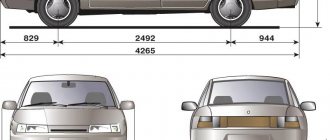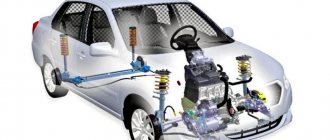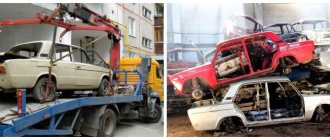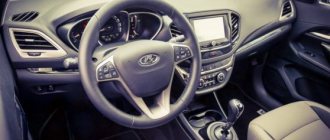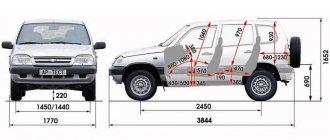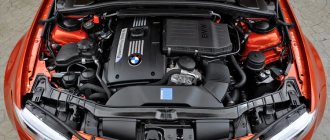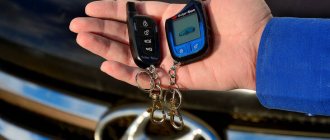The width of cars, like other overall dimensions, is an important indicator on which the vehicle’s maneuverability in specific places depends. This classification is usually used by equipment manufacturers, which makes it possible to determine the position of the model in the market. However, there are international requirements that allow a vehicle to be classified into a certain group. The final indicators of this value do not have clear boundaries and vary from country to country.
What are the overall dimensions of the car?
Each passenger car or cargo motor vehicle has its own overall dimensions. The width of the cars, as well as the height and length, are specified in any operating instructions for the unit. You can also find similar indicators in thematic tables or sections.
Dimensions parameters make it possible to evaluate maneuver options in a given situation. The length of the car is determined between the maximum protruding elements in front and behind the vehicle. The width of the cars is calculated from the boundaries of the protruding mirrors, and the height is fixed at the highest point of the roof. All this allows you to calculate the capacity of the car in the garage or other places that have certain restrictions.
Dimensions of a garage for 1 car: optimal parameters
As a rule, most families in our country have one car, so most often motorists wonder what the optimal standard dimensions of the garage and car to take as a basis in order to build the most convenient garage.
What indicators should a garage meet:
- Place the car so that you can move around it without problems and have access to its bottom.
- The ceiling must be high so that it is possible to work with the roof of the car, for example, to install additional space on it for transporting things, bicycles, etc. In addition, the height of the garage can be important for convenient washing of the car.
- Strict consideration should be given to all necessary work surfaces and shelving, cabinets, tool racks, for any work to straighten small dents or to replace supplied vehicle parts.
- You should also take into account the presence of a repair hole or elevation under the bottom of the car.
Once the plan is completely ready, then all the surfaces, boxes, shelving and other necessary additions necessary for the motorist have been taken into account. After drawing up a plan, where all the necessary space has already been taken into account, you can look at what materials to use, whether to insulate or not, what kind of lighting equipment there will be, and also whether the garage should accommodate any functionality other than what is necessary for operating and repairing the car.
Thus, it becomes clear why there is an urgent need to know exactly what dimensions the car will have if the garage is already ready. If the garage is still only at the design stage, you can use averaged data. You can calculate them yourself, knowing the minimum dimensions of one desired car model and the maximum dimensions of another proposed car.
Peculiarities
The streamlining of the vehicle body is not only responsible for aesthetics, but also gives a certain coefficient of air resistance. A low indicator indicates good dynamics of the machine. The width of the cars also plays an important role in this regard. The pressure on the vehicle becomes more noticeable at speeds above 55 km/h. The majority of modern sedans have a drag coefficient of no higher than 30. Jeeps, crossovers and trucks, due to the angularity of their shapes, have this parameter in the region of 40-50 units. The best aerodynamic capabilities are found in sports cars, which have the most streamlined body and additional systems that level air resistance.
The concept of “cabin width” includes the distance measured from the right to left door panel. Rear parameters may differ from front parameters due to original design and construction solutions. Users are particularly concerned about legroom. Due to their features, some cars have a minimum of this space, which is not always convenient for tall people. In turn, spacious interiors logically increase the overall dimensions of the vehicle and its cost in materials.
Exercises
Here are a few exercises you can do on your own to improve your driving skills and your sense of the car's dimensions. Cone workout:
- For this exercise you will need: a flat area, cones. In the absence of the latter, you can use plastic bottles filled with sand. And to make them more noticeable, stick long poles with bright pieces of fabric into them. The main condition for homemade cones is excellent visibility.
- Park the car on a level, hard-surfaced area. Place cones around it at a short distance. In front and behind or on the sides - depending on what you want to train. Then start the exercise. Carefully drive up to the cones, as close as possible, but without touching them. To begin with, place the flags further away, then, if you have a successful passage, gradually move them towards the car.
The skill of avoiding potholes on the roads (whatever you say, every motorist needs such exercises):
- For training you will need two plastic bottles. Alternately place one under the right and then under the left wheel.
- Try running over a bottle. You can also practice with the rear wheels.
- Then place two plastic bottles so that they are between the wheels. And drive through them.
- If you didn’t run over bottles, then you won’t be in danger of any potholes on the roads either.
An interesting exercise will help you practice braking and determine the length of your braking distance:
- Build a conditional wall. For it you will need a choice of: empty cardboard boxes, cones. Install them at a distance.
- Then get into the car and pick up speed, heading towards the conditional wall.
- Slow down in front of her. An indicator of your skill will be stopping at the shortest possible distance in front of the wall.
Do the well-known “snake” and “figure eight” exercises. Moreover, practice performing them both in front and in reverse.
Passenger car width: nuances
European qualification of cars is based on several positions. Among them:
- Width.
- Length.
- Height.
- Weight.
- Price.
- Set of options.
- Optional equipment.
Determining the width of a car is much easier on domestic models VAZ, GAZ, UAZ. They are produced according to certain standards, and each series meets its own parameters. With foreign cars it is a little more difficult. This is due to the fact that they are being finalized and improved. And this often leads to an increase in the size of the car. It is worth noting that expanding the dimensions by 100-150 millimeters is considered a positive factor. Classification by size is carried out using the Latin alphabet (from A to F). A special group of vehicles is marked with the letters S, J, M.
Domestic cars
In the Russian automobile industry, category “A” includes cars less than 3.6 meters long and no more than 1.6 meters wide. Such specimens are comparable to the Oka. Class “B” is designed for a length of 3.9 meters. The width of cars in this group should not exceed 1.7 m. This category includes Tavria and brands similar in size.
The middle class “golf” includes specimens whose length and width reach 4.4/1.75 meters. This group includes modifications of the VAZ-2106 and 2107. Categories D, E, F reach parameters of 4.7/1.8 meters. The 41st Moskvich, as well as the Lada Granta and Kalina, fit into this classification.
Segment D
Middle class
- middle or family class, presented in hatchback, sedan, station wagon bodies, with spacious interiors and voluminous trunks. This segment is usually divided into ordinary family models and luxury models, which, according to other classifications (for example, British) are allocated to a separate compact executive car segment.
Typical representatives of the class: Chrysler 200, Honda Inspire, SAAB 9-3, Opel Insignia, Peugeot 508, Mazda 6, Ford Mondeo, Toyota Avensis, Hyundai Sonata, Renault Latitude, Volkswagen Passat, Kia Optima, Audi A4, BMW 3, Mercedes- Benz C-Class, Lexus IS, Volvo S60, Citroen C5, Citroen DS5, Suzuki Kizashi, Subaru Legacy.
Foreign cars
The length and width of a foreign-made car is commensurate with domestic units.
- Class A. These are vehicles designed to travel through tight city streets. Representatives: Daewoo Mathis, Renault Twingo and other small cars.
- Category B. These cars are among the most popular European models. The volume of the power unit does not exceed 1.6 liters. Popular models are Opel Astra, Nissan Micra, Ford Fiesta, Skoda Fabia and similar modifications.
- Class C includes more spacious cars, such as the Volkswagen Golf.
- Class D – these are models with a spacious interior and luggage compartment. Among them are Volkswagen Passat and Toyota Avensis.
- Category E – executive class cars (“Jaguar”, BMW-5, “Caddillac”).
- Segment F – long cars in the passenger class (Rolls-Royce, BMW-7, Hyundai Ecus) and others.
Load capacity
The overall dimensions of Gazelle cars place them in the lightest category. Their carrying capacity is 1.5-1.7 tons.
Minibuses have a slightly larger carrying capacity (1.5-2 tons). These machines develop quite good speed and allow the freight forwarder to accompany the cargo in the driver’s cabin.
The next category includes trucks of domestic and foreign production. Their carrying capacity is in the range of 3.5-7 tons. Their body can be tent or all-metal. They are used both for movement within the city and between them.
The next class is 10-ton trucks. They are also divided into subgroups. The first of them includes vehicles with a carrying capacity of 5-10 tons and a body volume of up to 36 cubic meters. m. The second group is also characterized by a tonnage of up to 10 tons, and their compartment volume is up to 56 cubic meters. m. The overall dimensions of KAMAZ vehicles are most suitable for the third group. Their carrying capacity is 10-15 tons, and the body has a volume of up to 60 cubic meters. m.
The next category unites vehicles with a carrying capacity of 20 tons. The container of such vehicles is called sea. It comes in 20 or 40 pound sizes. In the second case, the carrying capacity increases to 28 tons.
“Eurotents” are distinguished as a separate group. These are semi-trailers with a carrying capacity of 20-22 tons.
Trucks
The width of a truck depends on its purpose and load capacity, but must comply with accepted road regulations. As a rule, the possibility of transportation by these vehicles ranges from 1.5 to 30 tons. It all depends on the owner’s requirements and the characteristics of the cargo.
Specialized trucks can transport up to 40 tons. Such transport includes container ships, timber carriers, refrigerators, tractor-trailers, as well as thermally protected vans and containers.
Special groups
Group S includes sports cars: sports cars and supercars.
The M segment refers to minivans. They are sometimes used for cargo and passenger transport. The seats can be folded or removed. The overall dimensions of trucks are classified differently. And minivans are not one of them. Therefore, this type of machine is classified as a special group.
They have sliding doors and a fairly large height. Their capacity is quite good. Speed and driving characteristics are close to those of passenger cars.
The most famous representatives of this class are Ford Galaxy, Huyndai H-1, Fiat Doblo and many others.
Off-road vehicles belong to group J.
How to control dimensions?
The width of the cars, like the length, can be visually controlled by the driver while driving. The windshield and mirrors are used for this. This solution allows you to select the correct radius and turning time, and also facilitates normal parking.
Before getting behind the wheel on his own, the owner must feel the size of the car taking into account its behavior on the road. The optimal solution would be to study theory and combine it with practical skills.
Knowing the theory about vehicle dimensions will help with this. Driving practice will help reinforce the feeling of distance between objects and the car, no matter what category it belongs to. Each user who treats this matter conscientiously contributes to ensuring road safety and reducing the number of road accidents.
Landmarks
We offer you several guidelines to help novice drivers. So, to prepare special markings inside the car, you will need a flat asphalt area, chalk and adhesive tape:
- Park your car in a specific area.
- Use chalk to draw lines forward from the front and rear wheels. They should be quite long, since you will need to view them while sitting in the cockpit.
- After you have drawn the lines, take a seat in the driver's seat. Make yourself comfortable, as if you are about to travel. Now mentally continue the line from the wheels through the hood to the front panel.
- Place a piece of duct tape at the point where it intersects with the windshield. Do the same with the rear wheels.
Such landmarks will help you understand where the wheels are heading when driving. Once you begin to feel the size of your car, these colored stickers can be removed.
Peculiar landmarks for the end of the bumper are the installed antenna or “eyelashes for the headlights.” Using parking sensors or a camera will also be useful. If you have them installed in your car, follow their signals. This will greatly simplify the use of the car.
Dimensions of cars and trucks
If you look at the overall dimensions of a car, that is, by its length, width, height, thickness, then cars are divided into classes. Cars are also divided by type.
Class “B” includes cars that should not exceed 3.9 meters in length and, accordingly, no more than 1.7 meters in width. The “middle” class of passenger cars, or as they are often called the “golf” class, combines cars of a rather larger size than those in “A” and “B”. Their length should not exceed 4.4 meters, and accordingly their width should not exceed 1.75 meters.
Well, “D”, “E”, “F” are larger than all previous classes, their length can reach 4.7 meters, width - 1.7 meters. All of the listed classes do not include vehicles such as SUVs and sports cars.
In this video, they will tell you how to determine the dimensions of the car and what you need to know for this.
Classification of passenger car dimensions:
- “A” are “OKA” type cars.
- “B” - cars that are larger than the previous class, but not by much. They are the size of a Tavria.
- “Middle” class or class “C” is a very common class of cars. One of the representatives is the typical “Zhiguli”.
- “D” - the representative of this class is “Moskvich”.
- “E” is the largest class, differing in its length from all previous classes, a representative of the Volga.
Worth o - the most common in Europe. The whole world gives preference to classes “C” and “D”, although it is worth saying that the other classes are only a small part behind them. There are also additional classes that were invented specifically for cars that do not fall into those listed above.
So, class “S”, this class includes cars such as sports cars, coupes or convertibles. Class “M”, this category of dimensions includes minivans, or cars with increased capacity. Class “J”, this category includes crossover-type cars.
There is also a class for SUVs. Most of all, this type of car is popular and in demand among residents in the USA, since this type of car is quite prestigious and comfortable.
The dimensions of trucks are made according to international standards, which facilitate the transportation of cargo in containers or other containers. The dimensions of the trucks are specially made to accommodate cargo containers that weigh twenty or forty feet.
Categories of vehicles in technical regulations (M1, M2, M3, N)
Good afternoon, dear reader.
In 2022, the technical regulations of the Customs Union on the safety of wheeled vehicles will be applied in Russia. This regulatory document contains requirements for the technical condition of vehicles. Compliance with these requirements is also verified during a technical inspection of the vehicle.
The technical regulations of the customs union came into force quite a long time ago, but not every driver had to deal with them. The peculiarity of the regulation is that it uses special categories of vehicles that have not previously been found in regulatory legal documents.
This article will discuss the categories of vehicles in the regulations, as well as the vehicles to which these categories relate:
Table of categories in technical regulations
Motor vehicles
Mopeds, motorbikes, mokikis
Category L1 – Two-wheeled vehicles whose maximum design speed does not exceed 50 km/h and characterized by:
- in the case of an internal combustion engine - with an engine displacement not exceeding 50 cm3, or
- in the case of an electric motor - rated maximum power in continuous load mode not exceeding 4 kW.
Category L2 – Three-wheeled vehicles with any wheel arrangement, the maximum design speed of which does not exceed 50 km/h, and characterized by:
- in the case of an internal combustion engine with forced ignition - an engine displacement not exceeding 50 cm3, or
- in the case of another type of internal combustion engine - a maximum effective power not exceeding 4 kW, or
- in the case of an electric motor - rated maximum power in continuous load mode not exceeding 4 kW.
With scooters the situation is quite simple:
- If the scooter has 2 wheels, then it belongs to category L1.
- If the scooter has 3 wheels, then it belongs to category L2.
Thus, categories L1-L2 correspond to motor vehicles, which require a driver’s license of category M to drive.
Motorcycles, scooters, tricycles
- Category L3 - Two-wheeled vehicles whose engine displacement (in the case of an internal combustion engine) exceeds 50 cm3 (or) the maximum design speed (for any engine) exceeds 50 km/h.
- Category L4 – Three-wheeled vehicles with wheels asymmetrical with respect to the median longitudinal plane, the engine displacement (in the case of an internal combustion engine) exceeds 50 cm3 and (or) the maximum design speed (for any engine) exceeds 50 km/h.
- Category L5 – Three-wheeled vehicles with wheels symmetrical with respect to the median longitudinal plane of the vehicle, the engine displacement (in the case of an internal combustion engine) exceeds 50 cm3 and (or) the maximum design speed (for any engine) exceeds 50 km/h .
- If the distance between the centers of the contact patches with the road surface of the wheels of one axle is less than 460 mm, such vehicles belong to category L3.
Categories L3-L5 refer to vehicles that require a category A driver's license to drive:
- L3 – two-wheeled motorcycles, as well as three-wheeled motorcycles with a small distance between the wheels on the axle (less than 46 cm);
- L4 – asymmetrical three-wheeled motorcycles (for example, a motorcycle with a sidecar);
- L5 – symmetrical three-wheeled motorcycles (for example, a motorcycle with a body in the center).
Quadricycles
Category L6 – Four-wheeled vehicles whose unladen mass does not exceed 350 kg excluding the mass of batteries (in the case of an electric vehicle), the maximum design speed does not exceed 50 km/h, and characterized by:
- in the case of an internal combustion engine with forced ignition - an engine displacement not exceeding 50 cm3, or
- in the case of another type of internal combustion engine - a maximum effective engine power not exceeding 4 kW, or
- in the case of an electric motor - the rated maximum power of the engine in continuous load mode, not exceeding 4 kW.
Category L7 - Four-wheeled vehicles other than vehicles of category L6, the unladen mass of which does not exceed 400 kg (550 kg for vehicles intended for the carriage of goods) excluding the mass of batteries (in the case of an electric vehicle) and the maximum effective power motor does not exceed 15 kW.
From the point of view of traffic rules, quadricycles of category L6 are mopeds, i.e. to drive them, a category M license is required. More powerful quadricycles of category L7 require subcategory B1 licenses.
The division between categories L6 and L7 is made solely on the basis of engine power. More powerful quadricycles belong to the L7 category.
Passenger vehicles
Passenger cars
Category M1 – Vehicles used for the transport of passengers and having, in addition to the driver’s seat, no more than eight seats – passenger cars.
Comparison of cars and trucks
Each car has its own personal personality. Cars, both trucks and cars, have their positive and negative qualities. Many people say that a car is not a luxury, it is a means that helps maintain strength and health.
Passenger cars are designed for recreation or for personal needs (to go on vacation, go to work or on business).
The buyer chooses each type of car according to its technical characteristics and, of course, the price that suits you best.
